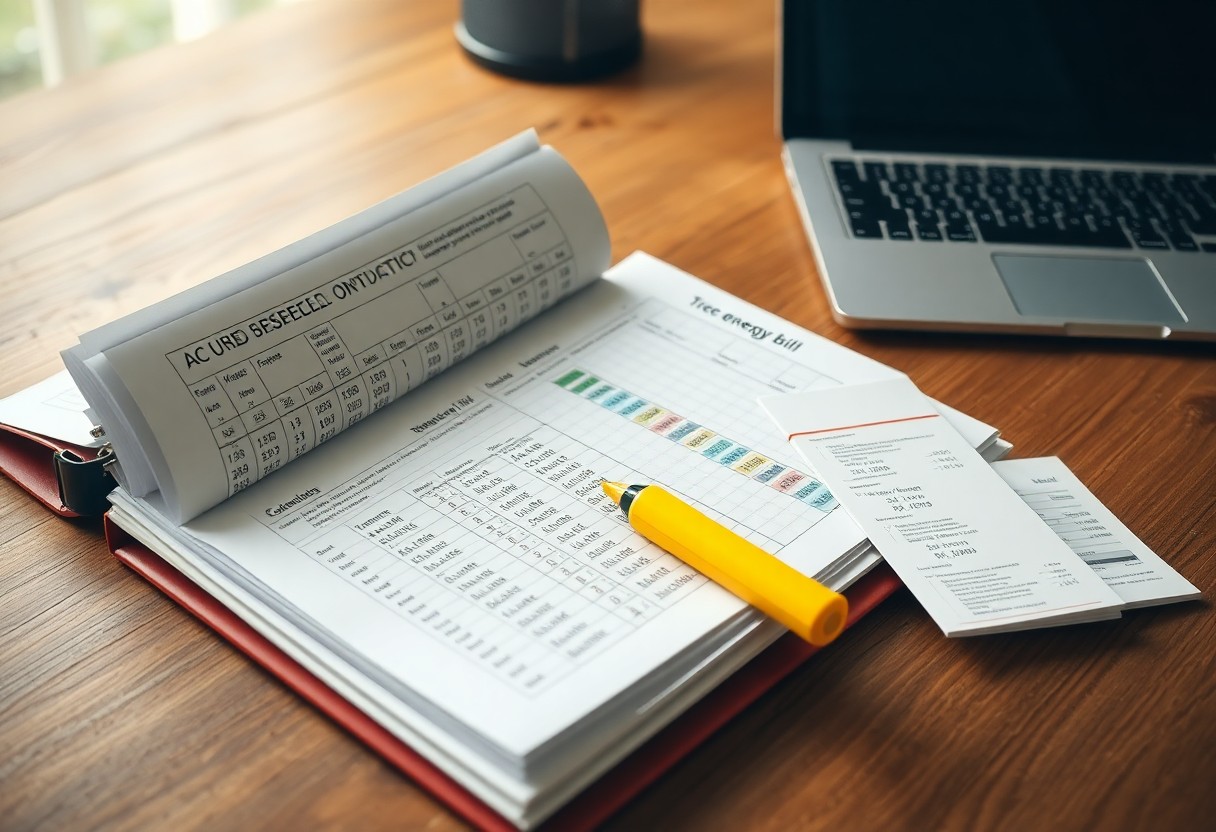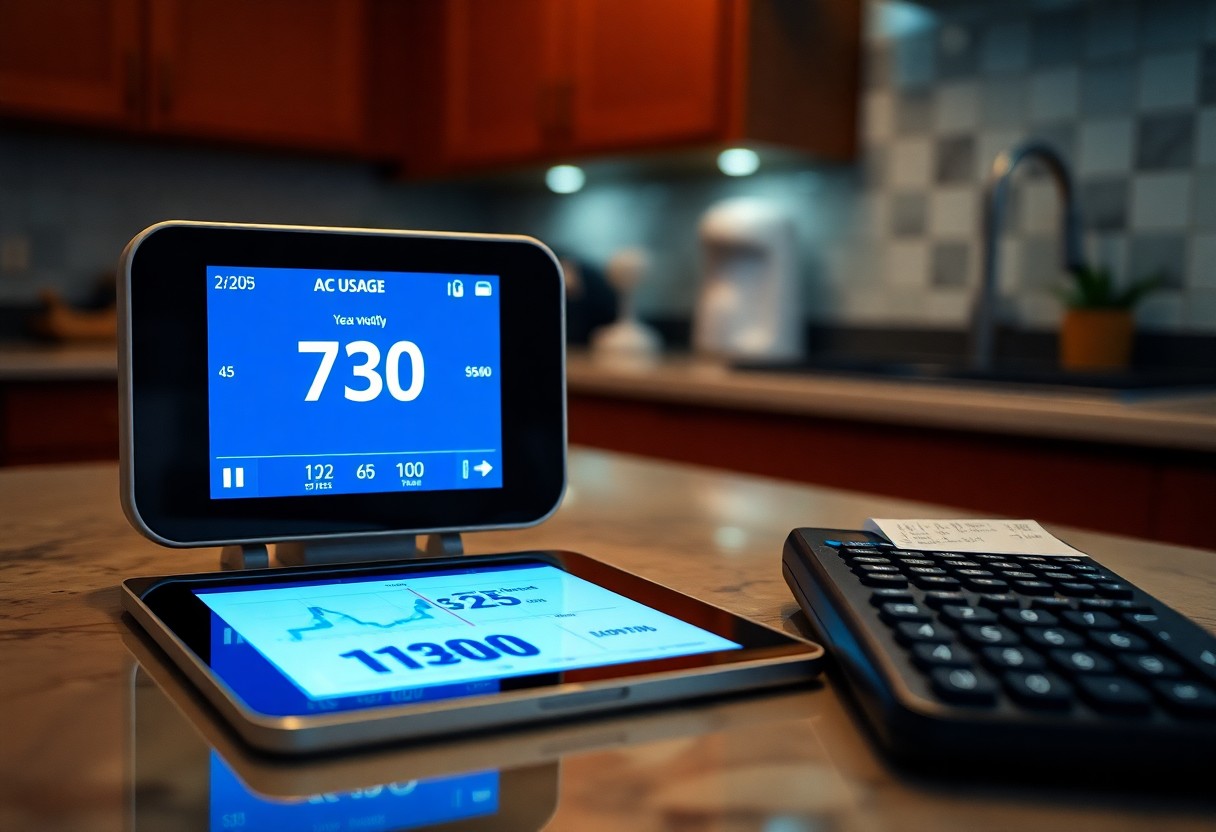There's a good chance you've wondered how your air conditioning habits affect your energy bills. By meticulously tracking your AC usage over an entire year, you can uncover surprising insights that lead to significant savings. This post will guide you through the findings, showing you how small adjustments in your cooling practices can make a remarkable difference in your monthly expenses. Get ready to transform your approach and keep more money in your pocket while staying comfortable all summer long.

Key Takeaways:
- Monitoring AC usage leads to a significant reduction in energy bills.
- Optimal temperature settings can enhance energy efficiency.
- Timing of AC usage, such as peak vs. off-peak hours, greatly impacts costs.
- Regular maintenance ensures better performance and efficiency.
- Utilizing additional cooling methods can reduce reliance on AC systems.
Understanding AC Usage
Tracking your air conditioning usage unveils patterns that impact your energy expenditure significantly. By closely observing when and how your AC runs, you can identify opportunities for savings. For example, understanding peak usage times allows you to adjust settings to take advantage of lower energy costs, potentially decreasing bills up to 30% depending on your habits. Your insights can shape a more efficient home environment.
Importance of Monitoring
Monitoring your AC usage empowers you to make informed decisions about energy consumption. You can pinpoint inefficiencies or excessive usage that might go unnoticed otherwise. Armed with this data, adjustments such as altering temperature settings or scheduling usage can lead to substantial savings, ensuring that you maximize comfort without unnecessary cost.
Typical Usage Patterns
Identifying typical AC usage patterns is crucial in understanding your overall energy consumption. Most households find that usage spikes during peak summer months, especially during the hottest parts of the day. Additionally, it's common for people to run AC units longer on particularly hot days, often leading to inflated bills. Many users also tend to overlook the impact of running the AC while at home versus away, which can significantly influence monthly expenses.

Data Collection Methodology
Your journey began with a clear data collection strategy. You logged daily usage hours and energy consumption, tracking AC settings and outside temperature fluctuations. Following experts say air conditioning strategy can save money when paired with efficient monitoring, the results revealed insightful trends in energy expenditure and comfort levels throughout the seasons.
Tools and Techniques Used
Consistency in Tracking
Staying consistent with your tracking was vital for accurate data collection. You committed to recording AC usage daily, ensuring no gaps in your data. This helped you establish reliable trends over time, reinforcing the impact of behavioral changes on energy consumption and costs.
Consistency in your tracking provided a comprehensive understanding of your AC usage patterns. By maintaining a daily log, you were able to correlate temperature settings with changes in the energy bill, allowing for strategic adjustments to save money during peak usage periods. This habit made it easy to identify patterns that would have otherwise gone unnoticed, ultimately leading to significant cost savings.
Analyzing the Results
After a year of consistent monitoring, the insights gained from tracking your AC usage reveal surprising patterns and savings. You can pinpoint not only how much energy your system consumed but also how minor adjustments can lead to significant cost reductions. By dissecting this data, you'll uncover specific opportunities to optimize your system's efficiency and practices.
Monthly Breakdown of Usage
Your monthly AC usage varied significantly throughout the year, with the hottest summer months showing a clear spike. By comparing your energy expenditure against these monthly figures, you will identify trends that suggest potential areas for adjustment and improvement in efficiency. This analysis helps in planning for next year's cooling needs.
Peak Usage Periods
The analysis highlighted specific peak usage periods—typically, the height of summer led to usage surges. Understanding these peaks allows you to strategize around your AC operations, adjusting settings or investing in more efficient cooling methods during these critical times to lessen financial impact.
For instance, examining the data reveals that in July and August, your AC ran an average of 25% more than in the spring months. During these peak periods, determining the optimal set temperature or using programmable settings could yield savings of 10-15% on your monthly energy bills. Shifting some of your cooling needs to late evenings or early mornings when energy demand is lower offers a practical way to further cut costs.
Financial Impact of AC Usage
Your tracking revealed a significant financial impact associated with air conditioning usage. Many households underestimate the cost of running their AC, leading to unexpected spikes in energy bills during peak months. With your year-long data, you can now clearly see these expenses, allowing for informed decisions about when and how to use your system more efficiently.
Cost Analysis
The analysis showed that your air conditioning system accounted for nearly 50% of your total energy expenditure during the hottest months. By calculating the exact kilowatt-hours consumed, you discovered specific months where you incurred the highest costs, helping you identify potential adjustments to your usage habits.
Savings Opportunities
Your data uncovered several areas for potential savings. Adjusting the thermostat settings by just a few degrees and integrating smarter cooling strategies, like using fans or closing blinds, can yield substantial savings. Small changes can lead to noticeable differences in your monthly energy bills.
Implementing a few strategic adjustments can significantly lower your air conditioning expenses. Consider these practical tips:
- Set your thermostat to a higher temperature during the day.
- Use fans to circulate cool air throughout your home.
- Close blinds and curtains during peak sunlight hours.
- Regularly clean or replace your AC filters.
- Schedule annual maintenance for your AC unit.
The combination of these strategies can lead to substantial savings.
Efficient Usage Practices
Optimizing your air conditioning habits can greatly reduce costs. Keep your thermostat at 78°F when you're home and raising it by a few degrees when you're out. Utilize ceiling fans to create a cooling breeze, allowing you to set the thermostat higher without sacrificing comfort. Additionally, limit heat-generating activities like cooking or using heat-producing appliances during the hottest parts of the day.
Technological Solutions
Modern technology offers several solutions to enhance energy efficiency. Smart thermostats learn your schedule and adjust temperatures accordingly, often allowing for remote control via an app. Specialty AC units with advanced inverter technology operate more efficiently than traditional units, using only the necessary energy to maintain your desired temperature.
These solutions can significantly impact your monthly utility bills. For instance, a smart thermostat could save you as much as 10-15% on cooling costs annually. Moreover, inverter AC systems adjust their cooling output, consuming less energy and leading to lower bills. Investing in these tools not only optimizes comfort but also makes fiscal sense over time. Transitioning to energy-efficient appliances, supplemented by smart home technology, can enhance both savings and convenience.
Lessons Learned from My Year of Tracking
Tracking your AC usage over the year reveals patterns and opportunities for improvements. You gain insight into peak usage times, enabling you to adjust settings and routines for maximum efficiency. This newfound awareness can lead to habit changes that translate into substantial savings. Each small adjustment made throughout the year compounds, contributing to an overall positive impact on your budget and the environment.
Changes in Behavior
Adopting a more mindful approach to your AC usage encourages proactive habits. You may start setting the thermostat higher when leaving home, using ceiling fans, or closing blinds during peak sun hours. As you prioritize these actions, they can become second nature, creating a more energy-efficient lifestyle.
Long-Term Financial Benefits
Consistently monitoring your AC usage over time has lasting financial advantages. The cumulative savings from minor adjustments can add up significantly, impacting your annual budget. By investing in energy-efficient appliances or systems, you can further amplify these benefits, reducing not just your monthly bills but also avoiding costly repairs and replacements in the long run.
For example, if you lower your AC usage by just 10% through simple behavior changes, you could save around $120 per year, assuming an average bill of $1,200. Over five years, that's a savings of $600, not including any additional benefits from improved efficiency. Moreover, utility companies often offer rebates for energy-efficient upgrades, providing additional incentives that boost long-term savings and environmental impact. Making these strategic adjustments will not only lighten your monthly expenses but can also increase your home's value as energy efficiency becomes a more significant selling point.
To wrap up
Ultimately, tracking your AC usage over the year can lead to significant savings on your energy bills. By understanding your consumption patterns, you can make informed adjustments to optimize performance and efficiency. This proactive approach not only reduces costs but also contributes to a more sustainable environment. As you analyze your findings, you'll discover practical strategies to enhance your home's comfort while minimizing expenses. The results may surprise you and motivate you to maintain these habits long after your tracking period ends.
FAQ
Q: What methodology did you use to track your AC usage?
A: I used a combination of smart thermostats, energy monitoring devices, and monthly electric bill analysis to gather data on my air conditioning consumption over the year.
Q: What was the total savings achieved from tracking AC usage?
A: I saved approximately 25% on my annual energy bill specifically attributed to efficient air conditioning practices and habit changes based on usage data.
Q: Did you make any changes based on the tracking results?
A: Yes, I adjusted the thermostat settings, scheduled regular maintenance for the unit, and implemented better insulation and shading techniques in my home.
Q: How did tracking AC usage influence your energy habits?
A: It made me more aware of peak usage times and encouraged me to use the AC more efficiently, like utilizing fans and closing curtains during the hottest parts of the day.
Q: What tools or apps did you find helpful in tracking AC efficiency?
A: I found energy monitoring apps such as Sense and several smart thermostat features very helpful for tracking AC efficiency, offering real-time insights and energy usage patterns.